 Religioon
ReligioonРелигия
Religion
 Religioon
Religioon
The building of Tallinn New Synagogue is one of the most unusual sacred constructions in the capital of Estonia. It has intertwined contemporary design and the traditions of synagogue architecture.
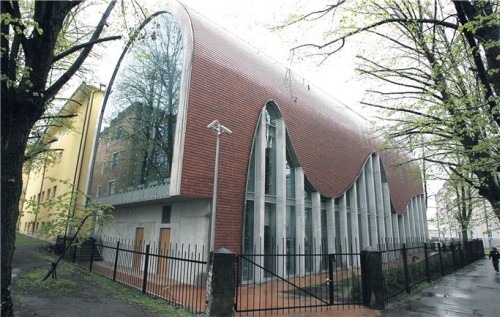 The rounded external façade of the building unites this project with the architectural format of other synagogues, and the curved lines cutting into the lateral pylons and glass walls remind visitors of the destiny of Estonian Jewry – the years of rising numbers and of success which were followed by decline and persecution, and afterwards came the new revival. The lines start from the foundation of the wall, to which the glances of the congregation in the main hall are directed. This wall is oriented towards Jerusalem, thereby emphasizing that the Jewry of the Diaspora, including Estonian Jewry, has its roots in the Holy Land of Israel. Afterwards the lines repeat as it were the historical path of Estonian Jewry – the rise and decline during Tsarist times, a new rise to its maximum height during the first Republic of Estonia (1918-1940), the deep tragic fall during the Holocaust period and then the oppression of the Soviet regime. The final rise in the lines from the side of the entrance into the building emphasises the revival of the Jewish community in recent decades. Large glass areas of the walls and skylights fill all the rooms with light and create the ambience of solemnity.
The entrance doors are decorated with ornamentation symbolizing the tree. We will see it as the decorative element of design also in the interior of the building.
The rounded external façade of the building unites this project with the architectural format of other synagogues, and the curved lines cutting into the lateral pylons and glass walls remind visitors of the destiny of Estonian Jewry – the years of rising numbers and of success which were followed by decline and persecution, and afterwards came the new revival. The lines start from the foundation of the wall, to which the glances of the congregation in the main hall are directed. This wall is oriented towards Jerusalem, thereby emphasizing that the Jewry of the Diaspora, including Estonian Jewry, has its roots in the Holy Land of Israel. Afterwards the lines repeat as it were the historical path of Estonian Jewry – the rise and decline during Tsarist times, a new rise to its maximum height during the first Republic of Estonia (1918-1940), the deep tragic fall during the Holocaust period and then the oppression of the Soviet regime. The final rise in the lines from the side of the entrance into the building emphasises the revival of the Jewish community in recent decades. Large glass areas of the walls and skylights fill all the rooms with light and create the ambience of solemnity.
The entrance doors are decorated with ornamentation symbolizing the tree. We will see it as the decorative element of design also in the interior of the building.
 This emphasizes that the Torah resembles the tree of life to us, from which our people for centuries drew the energy for its existence. This synagogue building also resembles an image of the Torah scroll, which will be installed above the entrance, because the reading of the Torah is one of the most significant elements of our services.
This emphasizes that the Torah resembles the tree of life to us, from which our people for centuries drew the energy for its existence. This synagogue building also resembles an image of the Torah scroll, which will be installed above the entrance, because the reading of the Torah is one of the most significant elements of our services.
When entering the building, we get into the vestibule, which can simultaneously function as lecture hall. A part of the stairs leading to the main hall on the second floor is designed as sitting benches for 70 people. The wall to the right of the entrance may be transformed into a screen for the demonstration of visual materials or films, and it will have other uses for events conducted in the hall. Here at the entrance men can when necessary receive skullcaps for temporary use, since it is inappropriate to enter a synagogue with the head uncovered.
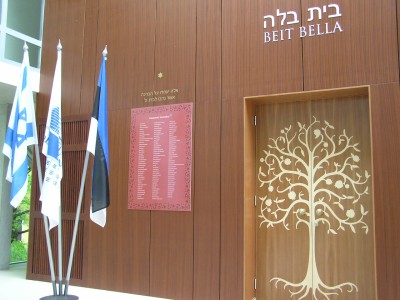 One can reach the first floor by the stairs, (or the second floor using American and Estonian usage). A lift is planned for those unable to walk, and it is situated to the right of the stairs. Toilets are situated beside the lift.
One can reach the first floor by the stairs, (or the second floor using American and Estonian usage). A lift is planned for those unable to walk, and it is situated to the right of the stairs. Toilets are situated beside the lift.
On the outer wall, at both sides of the entrance to the main hall tablets have been erected with the names of the people who made donations for the construction of the synagogue. Entering the hall, we can see in front of us the glass wall, and in front of it on the pedestal is the most significant and valuable object of each community – the cabinet, where the Torah Scrolls are stored, – Aron Kodesh. The scrolls are removed from it only for the reading of the weekly portion. During the Torah Festival – Simchat Torah, one can see all the scrolls at the same time.
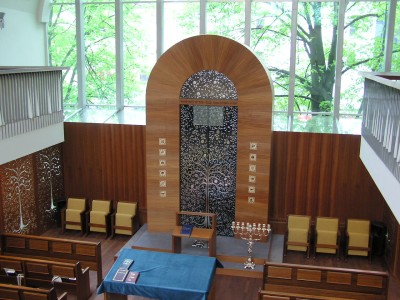 Next to Aron Kodesh, is displayed the stone from Jerusalem, which was delivered here by the President of Israel. On both sides of the Aron Kodesh are places for the rabbi and the most important guests. In front of the Aron Kodesh is located the bimah, where the Torah Scroll is taken for reading. Between the bimah and Aron Kodesh there is placed the pulpit, from which the cantor or shaliakh tzibur chant the prayers. 105 people can sit on the benches in the hall. Around the hall there is a space, which is used for passing around the congregation during the extraction of the Torah Scroll. The cabinets along the walls contain the prayer books and printed editions of Torah and Tanakh. Since during the prayer nothing should disturb the congregation, the lateral windows are separated by the gallery, which does not hinder the penetration of light into the hall.
Next to Aron Kodesh, is displayed the stone from Jerusalem, which was delivered here by the President of Israel. On both sides of the Aron Kodesh are places for the rabbi and the most important guests. In front of the Aron Kodesh is located the bimah, where the Torah Scroll is taken for reading. Between the bimah and Aron Kodesh there is placed the pulpit, from which the cantor or shaliakh tzibur chant the prayers. 105 people can sit on the benches in the hall. Around the hall there is a space, which is used for passing around the congregation during the extraction of the Torah Scroll. The cabinets along the walls contain the prayer books and printed editions of Torah and Tanakh. Since during the prayer nothing should disturb the congregation, the lateral windows are separated by the gallery, which does not hinder the penetration of light into the hall.
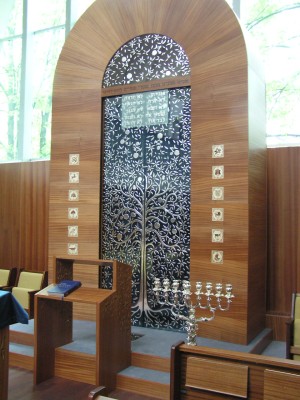 This is also helped by the glass apertures in the ceiling. During hours of darkness, the hall is lit by the beam of the projectors directed upwards, which is reflected from the ceiling, and also by two decorative lustres under the ceilings. The hall has excellent acoustics, which was proved in a special test using computer equipment. Special sound-reflecting blocks are installed on the slanting wall surfaces. The hall is designed for use as a concert-hall. Taking into account the additional chairs it can accommodate up to 230 people.
When facing the main entrance, to the right are the stairs leading to the second (third) floor. This accommodates the balcony of the main hall, surrounding it on three sides and planned for women coming to the service. Here the total is 78 places. From the side opposite the entrance to the balcony are the official premises of the community, including the offices of the Rabbi and Chairman. To the right from these, the stairs lead to the third (fourth) floor, where on the opposite side from the hall, from the side of the Karu Street, is the big hall for the temporary exhibitions and for the permanent museum. The semi-rounded roof provided the designers with the opportunity to implement most unexpected layouts for the exhibitions.
This is also helped by the glass apertures in the ceiling. During hours of darkness, the hall is lit by the beam of the projectors directed upwards, which is reflected from the ceiling, and also by two decorative lustres under the ceilings. The hall has excellent acoustics, which was proved in a special test using computer equipment. Special sound-reflecting blocks are installed on the slanting wall surfaces. The hall is designed for use as a concert-hall. Taking into account the additional chairs it can accommodate up to 230 people.
When facing the main entrance, to the right are the stairs leading to the second (third) floor. This accommodates the balcony of the main hall, surrounding it on three sides and planned for women coming to the service. Here the total is 78 places. From the side opposite the entrance to the balcony are the official premises of the community, including the offices of the Rabbi and Chairman. To the right from these, the stairs lead to the third (fourth) floor, where on the opposite side from the hall, from the side of the Karu Street, is the big hall for the temporary exhibitions and for the permanent museum. The semi-rounded roof provided the designers with the opportunity to implement most unexpected layouts for the exhibitions.
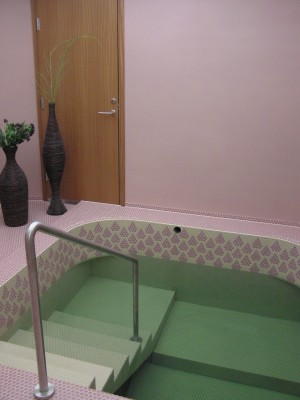 Now let’s come back to the vestibule on the ground (first) floor. To the left of the main stairs, the corridor leads us to a small kiosk, where various souvenirs and books are sold. It will also order and receive kosher products. For those who would like to taste real kosher food, on the first floor of the synagogue is the kosher restaurant 60 seats. It is the first kosher restaurant in post-war Estonia, where all the rules of kashrut are observed. The hall may also be used for family celebrations or for conducting festive events. The floor of the hall is decorated with a depiction of Magen David.
Tallinn New Synagogue accommodates the only mikvah in Estonia, i.e. pool for ritual ablution. The entrance into the mikvah is located at the back of the building. It includes the wardrobe, shower and bath, and also the ritual pool proper. The contemporary technological solutions comply in all respects with the requirements established by the Jewish tradition, and were tested for compliance by the rabbis who are specialists in the field and who have the right to issue the corresponding permits.
Now let’s come back to the vestibule on the ground (first) floor. To the left of the main stairs, the corridor leads us to a small kiosk, where various souvenirs and books are sold. It will also order and receive kosher products. For those who would like to taste real kosher food, on the first floor of the synagogue is the kosher restaurant 60 seats. It is the first kosher restaurant in post-war Estonia, where all the rules of kashrut are observed. The hall may also be used for family celebrations or for conducting festive events. The floor of the hall is decorated with a depiction of Magen David.
Tallinn New Synagogue accommodates the only mikvah in Estonia, i.e. pool for ritual ablution. The entrance into the mikvah is located at the back of the building. It includes the wardrobe, shower and bath, and also the ritual pool proper. The contemporary technological solutions comply in all respects with the requirements established by the Jewish tradition, and were tested for compliance by the rabbis who are specialists in the field and who have the right to issue the corresponding permits.
Tallinn New Synagogue is located on the corner of Karu and Aedvilja Street and completes the ensemble of the Jewish Centre. In addition to the synagogue proper, it includes the buildings of Tallinn Jewish School and the Community Centre. During the construction of the synagogue the inner courtyard was paved with a new cover.